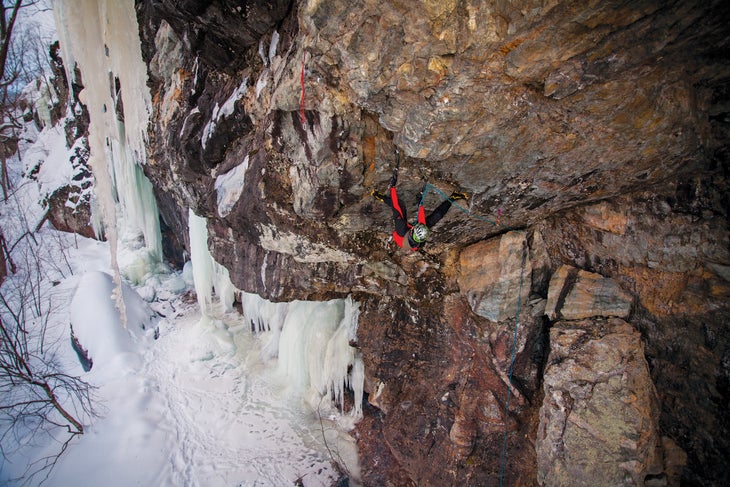
What is Mixed Climbing?
Mixed climbing is climbing that involves both rock and ice. Mixed climbs are climbed using a variety of tactics and protection. Typically, crampons and ice tools are used to climb, but gloved or bare hands can also come into play depending on temperatures and how dry the climb is. Often mixed climbing has dry sections which are devoid of ice, but still climbed with ice tools and crampons. This technique is known as dry tooling and allows climbers to ascend pitches with tiny holds or cracks where the hand and foot holds would be too small for most climbers.
Good to know: In strict rock climbing settings, climbs that feature both bolt protection and traditional protection are often referred to as mixed routes. Context would be used to indicates that the climb was a rock climb with mixed protection, rather than a "mixed climb."
Mixed Climbing Grades
Lower grades of mixed climbing have similar grading to Water Ice climbing grades as they often involve a lot of ice up to M6. As mixed routes become harder, they involve more and more steep rock and mixed grades take on their own characteristics involving a lot of dry tooling moves. Harder mixed routes become overhanging and eventually turn into horizontal roofs. It is extremely rare to find overhanging ice, such as that Helmecken Falls in Canada.
M Grades do not take into account the quality of the protection in the event of a fall as the harder grades are often pre-bolted routes. The grades focus on the technical and physical challenge of the route.
M1 - M3: Easy to Moderate, Rock Equivalent YDS 5.5-5.7
M1 through M3 routes offer a taste of mixed climbing without getting too committed. You don't need crazy gear or know crazy dry tooling moves. Routes in these grades are fairly casual as mixed climbing goes, with low angle climbing and less powerful moves that often don't require the use of ice climbing tools. They may feel a bit harder and less secure if you're on your first forays into mixed climbing.
- M1 (5.5 Rock Equivalent): Gentle terrain with easy moves on ice and rock, suitable for beginners.
- M2 (5.6 Rock Equivalent): Slightly steeper, straightforward routes requiring basic skills.
- M3 (5.7 Rock Equivalent): Moderate difficulty with more technical moves, requiring intermediate skills.
M4: Moderate to Challenging Mixed Climbing
- Rock Equivalent of 5.8
- Ice moves up to WI4
- Occasional technical dry tooling techniques required. Moves are typically standard dry tool placements and no wild dry tooling maneuvers like Figure 4s and Figure 9s.
M5: Challenging Mixed Climbing
- Longer and more sustained climbing than M4.
- Rock Equivalent of 5.9
- Longer and more consistent ice sections of WI4
- More technical dry tooling techniques required. Moves are still standard dry tool placements without Figure 4s or 9s.
M6: Vertical to Slightly Overhanging Mixed Climbing
- Rock Equivalent of 5.10
- Longer and more consistent ice sections of WI4-WI5. There may be pillars or broken icicles involved.
- More technical dry tooling techniques required. Probably requires torques, cams, Steinpulls and plenty of standard dry tooling edge placements. Might be reasonable to employ a Figure 4 or 9.
M7: Powerful moves on long, overhanging terrain.
- Rock Equivalent of 5.11
- Difficult and funky ice sections WI5-6. Be prepared to encounter bulges, hanging columns, and cauliflowers, candlesticks and more.
- More technical dry tooling techniques required. Requires consistent torques, cams, Steinpulls and probably a Figure 4 or 9.
- Expect 25-40m of sustained, powerful climbing with 5-15m of harder, cruxy climbing.
M8: Technical Dry Tooling with Harder Movement than M7.
- Rock Equivalent of 5.11+
- Difficult and funky ice sections WI5-6. Be prepared to encounter bulges, hanging columns, and cauliflowers, candlesticks and more.
- More technical dry tooling techniques required. Requires consistent torques, cams, Steinpulls and probably a Figure 4 or 9.
- Longer pitches of sustained, M7 climbing with punchier cruxes.
M9: Either a long, vertical climb with extremely technical holds, or a moderate route with a 3-6m horizontal crux section.
- Rock Equivalent of 5.12
- Consistent technical dry tooling techniques required.
M10: 30 meters or more of overhanging climbing and vertical climbing with little to no rest.
- Rock Equivalent of 5.12+
- Consistent technical dry tooling techniques required.
M11: 40+ meters of overhung, powerful climbing or 15m of pure horizontal climbing with little to no rest.
- Rock Equivalent of 5.13
- Consistent technical dry tooling techniques required.
M12: 20m of pure horizontal climbing or M11 with smaller, harder tool placements. Needless to say, little to no rest.
- Rock Equivalent of 5.14
- Consistent technical dry tooling techniques required.
M13-M16: Insanely technical and consistent climbing requiring orchestrated sequences and elite level execution. These grades get really hard to parse out and are highly subjective.

Here are Some Great Examples of Difficult Mixed Climbing
M11 Red Bull & Vodka | Vail Colorado
M15- Saphira | Vail Colorado
-
Lucka Hrozová climbing Saphira, M15- in Vail, Colorado.
M16? Helmcken Falls | Canada
- For a taste of M13-16, here's Will Gadd climbing the world's hardest Mixed Climb, Helmcken Falls.
- And a great synopsis of Will Gadd on Helmcken Falls by RedBull TV.
